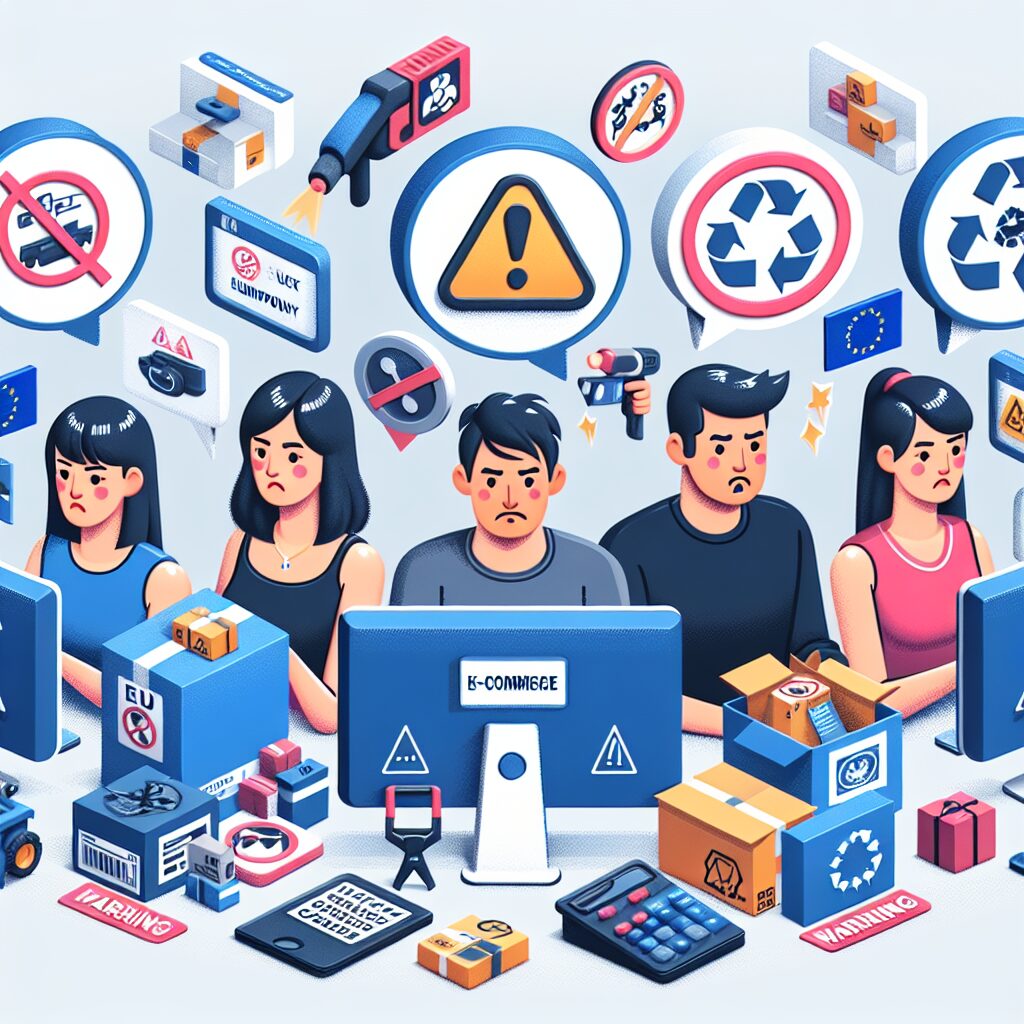About eldris
epr.eldris.ai leads the EPR sector, in fast, automated, AI Agent EU Complaince. LUCID Packaging, WEEE, and Battery Compliance for Brands, E-Commerce and Service based businesses expanding into the EU.
In This Article
- Register in every EU country where you sell electronic goods
- Ensure proper labelling on all electronic equipment
- Work with a recognised compliance scheme to simplify your obligations
- Use automation platforms to streamline reporting and documentation
- Take fast remedial action if you identify any WEEE mistakes
What is WEEE Compliance and Why It Matters
Understanding the Legal Obligations
The term “WEEE mistakes” refers to critical errors companies make in adhering to the Waste Electrical and Electronic Equipment (WEEE) Directive, a regulation that mandates the responsibility of producers for the entire lifecycle of electronic goods, from manufacturing to disposal. Failure to comply can lead to severe financial penalties, operational disruptions, and long-term reputational harm.
WEEE compliance is not merely a bureaucratic obligation—it is a legal and ethical imperative. It applies to manufacturers, importers, and online sellers who distribute electrical and electronic equipment (EEE) within the European Economic Area (EEA). The fundamental goal of WEEE is to reduce e-waste and incentivise sustainable recycling practices.
Online platforms and e-commerce sellers must ensure that their products are collected, treated, recycled, and reported according to national WEEE legislation. Non-compliance can result in being blacklisted from selling platforms or facing legal actions from environmental agencies.

1. Not Registering in Each EU Country
The Multi-National Compliance Pitfall
One of the most common WEEE mistakes is the failure to register in every EU country where you sell goods. Just because you are registered in one member state does not grant you blanket coverage for all. Each country has distinct national registers and compliance authorities with which you must separately enrol.
For example, if your online store reaches customers in Germany, France, and Italy, you are legally obligated to register individually in each of those countries. Ignoring this responsibility leaves you vulnerable to hefty fines and delivery restrictions within specific markets. Non-registration is viewed as a serious offence by regulatory bodies and is often tracked down during routine compliance checks by customs or environmental departments.
“Registering in only one EU country is not enough—compliance must be tailored to each jurisdiction.”
2. Incorrect Product Labeling
Misuse of Recycling Symbols and Compliance Logos
Another frequent WEEE mistake involves the mislabelling, or complete omission, of crucial symbols and compliance marks on your electronic products. The crossed-out wheelie bin icon, for example, is mandatory under the WEEE Directive and signifies that the item must not be disposed of with general household waste.
Labelling errors are particularly prevalent among smaller sellers on marketplaces like Amazon or eBay, where packaging design may be less regulated. Improper or absent labels make it difficult for recycling facilities to correctly process outdated electronics, leading to increased landfill waste and environmental hazards. Additionally, incorrect labels may be interpreted as counterfeit or non-compliant by customs officials, leading to seizure or returned deliveries.
To solve this, ensure your product diagrams, packaging, and accompanying user manuals display the correct symbols as required by each target country. Whether you are selling cameras, computers, or consumer gadgets, accuracy in labelling is not optional—it’s mandatory.
3. No Authorized Representative Appointed
Why You Need Representation Inside the EU
Online sellers located outside the EU, such as those based in the UK or United States, often overlook the essential requirement to appoint an authorised representative (AR) within the EU. This is one of the most costly WEEE mistakes non-EU sellers commonly make.
Your EU-based representative will be the official point of contact for compliance inspections, data reporting, and all legal correspondence with local authorities. Without an AR, your WEEE registration is invalid, leaving you exposed to sanctions and removal from sales channels. Moreover, most compliance schemes will require information to flow through your appointed AR, especially for products marketed directly to EU consumers.
Choosing the right representative is critical. They must be well-versed in WEEE legislation and responsible for maintaining ongoing obligations, including data submission and documentation updates. Learn more about EU EPR & WEEE Compliance for E-Commerce
4. Incomplete Documentation and Reporting
Data is Compliance—Track It Properly
Documentation is the backbone of WEEE compliance, yet incomplete or inaccurate record-keeping remains a recurring issue for sellers. Compliance authorities demand evidence that producers have adhered to requirements, such as weight-based product reports, import/export logs, and recycling certificates.
Each country requires regular submission of EEE sales figures, broken down by product category and total weight sold into the country. These reports must be accurate, timely, and appropriately archived. Failure to file reports not only results in fines but may also trigger audits where historic data is scrutinised.
To remain compliant, establish a documentation process supported by digital tracking systems. Ensure all sales data, product specifications, and recycling obligations are gathered in a centralised location accessible for reporting. Read a related article
5. Not Joining a Recognized Compliance Scheme
Third-Party Schemes Simplify Compliance & Audits
In every EU country, sellers must enrol in a recognised WEEE compliance scheme. These schemes function as intermediaries, helping you manage pickups, recycling logistics, and reporting duties. Surprisingly, many sellers mistakenly assume registration with a scheme is optional—it is not.
A compliance scheme not only helps you meet environmental obligations but also acts as your authority liaison. These organisations handle producer responsibility on your behalf, allowing you to focus more on commercial operations rather than regulatory red tape.
There is typically a fee involved which varies by country and product volume. However, this fee is vastly cheaper than the thousands of euros in fines levied for non-participation. Avoiding the biggest WEEE compliance errors
Automation and Reporting Tools for WEEE
Simplify Compliance in 2025
As the European regulatory landscape grows more stringent, smart sellers are turning to automation tools to streamline their WEEE obligations. These platforms offer services ranging from real-time waste reporting to document generation and regulatory reminders.
Adopting automation tools allows for fewer human errors and consistent submission of required data across jurisdictions. Cloud-based dashboards enable quick access to product classifications, weight info, and transaction logs—all essential for compliance.
By integrating these tools into your sales and logistics platforms, you reduce the risk of overlooking any regulatory step. Many of these systems also offer API integrations with marketplaces such as Amazon or Shopify, making real-time data syncing possible.
This is especially important in 2025, as multiple EU member states are planning to digitise audit inspections and increase enforcement. Proactively adopting these technologies puts you ahead of the compliance curve.
How to Fix WEEE Mistakes if You’ve Already Made Them
Remediation Resources & Next Steps
If you’ve already made WEEE mistakes, it’s critical not to ignore them. The sooner you address these errors, the less severe the consequences will be. First, conduct a full compliance audit. This will help identify gaps in registration, reporting, or labelling.
Next, reach out to the appropriate compliance authority in each relevant country. Most EU regulators offer guidance sessions for sellers attempting to rectify unintentional non-compliance. Penalties can sometimes be reduced if proactive cooperation and retrospective reporting are completed.
It may also be worth consulting a legal or environmental compliance advisor to draft a remediation plan. These professionals can fast-track your re-registration, update documentation, and establish new internal systems to prevent repeat errors. EU Responsible Person role for compliance
Amazon & Marketplace Seller WEEE Risks
Why Marketplace Sellers Are Most Vulnerable
Sellers using marketplaces like Amazon, eBay, and Etsy are particularly at risk of falling foul of WEEE regulations. Platforms are increasingly transferring compliance responsibility to individual sellers under the “producer” definition of the WEEE Directive.
Amazon, for instance, has begun requiring proof of WEEE registration for electronic product listings in specific countries. Failing to provide valid documentation may result in your listings being deactivated without notice.
Moreover, marketplaces collaborate closely with national compliance authorities to detect unregistered sellers. This data-sharing makes it easier than ever for regulators to identify and penalise non-compliers. If you’re selling electronics online, assume the burden of compliance rests solely with you unless otherwise stated in the platform’s policy.
Checklist to Avoid WEEE Mistakes in 2025
Practical Action Steps
Staying WEEE-compliant in 2025 doesn’t have to be overwhelming. Use this checklist to ensure you’ve covered all angles of your legal obligations:
- ✅ Register separately in every EU country where your products are sold
- ✅ Appoint an authorised representative if operating outside the EU
- ✅ Join a recognised compliance scheme in each country’s registry
- ✅ Label all products correctly with mandatory symbols
- ✅ File timely and accurate EEE waste reports by weight and product category
- ✅ Archive documentation for potential audits
- ✅ Use automation tools to track products, generate data, and schedule reports
- ✅ Run periodic audits to discover and correct past mistakes
Following this checklist will safeguard your business and support responsible environmental practices.
Conclusion & Key Takeaways
WEEE mistakes are more than a minor administrative oversight—they are critical compliance failures that can jeopardise your online business. From incorrect labelling to missing documentation and failure to register in multiple jurisdictions, each mistake carries its own risk. However, with the right systems and awareness in place, these errors are entirely preventable.
Beyond staying legal, WEEE compliance contributes to a larger, shared responsibility among producers to limit environmental damage and promote a sustainable economy. In 2025, as enforcement increases across the EU, taking proactive steps today will give your business a meaningful competitive advantage.
Great guide on top-5-weee-compliance-mistakes-online-sellers – Community Feedback
What is WEEE compliance for online sellers?
WEEE compliance ensures online sellers follow EU regulations for electronic and electrical products, including correct product registration, responsible recycling, and reporting, to reduce e-waste and avoid penalties.
What are common WEEE mistakes ecommerce sellers make?
Typical mistakes include skipping country registration, mislabelling products, failing to appoint an authorised representative, incomplete reporting, and not joining a compliance scheme for covered products.
How do I avoid WEEE penalties when selling in the EU?
Stay informed on national WEEE rules, register in each relevant country, use correct product markings, keep accurate records, and work with compliance partners or automation services for reporting and updates.










